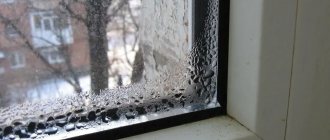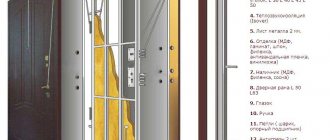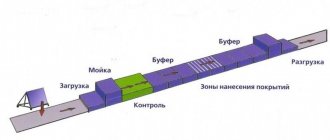When choosing a plastic window, we first look at the glass unit and profile. But a window is a complex mechanism with a large number of parts. The sashes, frame, fittings, and slope are not all the components of a window.
Each of them is responsible for one or another function: protects from noise, heat, dust, keeps the house warm or removes moisture. In the series of materials “What does a window consist of” I will tell you what each of its parts is needed for.
Today we’ll talk about distance frames.
Aluminum spacers
Aluminum is the most popular frame component. It is used by default in the manufacture of double-glazed windows. One of the reasons for this demand is the metal’s resistance to external influences. Although there are many color solutions on sale, during use they do not lose their color under the influence of ultraviolet radiation. Aluminum is not afraid of temperature changes. The design will remain unchanged for a long time.
Rice. 2. aluminum spacer
Aluminum profiles in the upper plane have small holes that run in two rows. There is an absorbent inside the configuration. Through the holes it can absorb moisture that forms in the space between the glass.
Rigid aluminum spacers
Rigid aluminum spacers, as the name suggests, have a very durable structure. They provide additional support to the glass unit. Such a durable frame is not subject to deformation. It is almost impossible to break it on your own.
Rice. 3. connection diagram of a rigid aluminum spacer frame
To assemble such a structure, special equipment is used, and the joints must be cut and welded. This is the only way to obtain a design that matches the shape of the frame. A rigid frame is more stable, but it is more difficult to work with, so it can increase the cost of a plastic window.
Flexible aluminum spacers
Rice. 4. connection diagram of a flexible aluminum frame
The flexible profile is also stable, but to a lesser extent. You can even bend it yourself, without any equipment. The frame will hold the shape that is given to it at the factory. There is no natural deformation from long-term use. Externally, it is easy to determine from the glass unit what type of aluminum profile was used. If the corners are sharp, it means the metal was welded, which is typical for a rigid structure. Flexible frames have a rounded shape at the corners with smooth outlines.
Distance frames for double-glazed windows
The most stringent requirements apply to the manufacture of double-glazed windows, as one of the main elements of the window. But it is through it that the main heat losses occur. To reduce them to zero, the main characteristics are taken into account: the required distances between the glasses (air chambers), the necessary microclimate inside the chamber itself, as well as good waterproofing. All of the above depends entirely on the spacer frame (the contour located between the glasses).
There are currently three main types of spacers on the market:
Aluminum spacers.
This is a common type used in double-glazed windows since its creation. The advantages of this type of spacer frame include only the affordable price, as well as the test of time, that is, the unchanged shape over time. Thanks to this, a double-glazed window with an aluminum spacer frame will perform well throughout the entire service life of the window. The disadvantage of the aluminum spacer frame is the high thermal conductivity coefficient, equal to 200-220 W/(sq.m. 186; C). This is 10 times higher than the thermal conductivity coefficient of plastic, which leads to a decrease not only in the thermal performance of the window, but also contributes to the formation of ice at the bottom of the double-glazed window in winter, because it is along the spacer frame that the so-called “cold bridge” passes
Steel foil spacer.
A spacer frame made of steel foil filled with polypropylene will help improve the situation with the “cold bridge”. Being a heat-insulating material, polypropylene reduces heat loss, and reducing the area of the metal base of the frame to 15% reduces heat loss through the “cold bridge”. However, such a solution leads to an increase in the cost of the spacer frame and, as a consequence, an increase in the cost of the double-glazed window.
Plastic spacer frame. Warm region
A relatively new type of spacer frames that has not yet received mass distribution. The frame structure is made of rigid PVC (polyvinyl chloride). Such a frame is not inferior in load-bearing capacity to a metal one, and in terms of thermal characteristics it is even 10 times superior ! The thermal conductivity coefficient of aluminum is 200-220 W/(sq.m.186;C), and PVC – 20 W/(sq.m.186;C). Thanks to this, the problem with the “cold bridge”, as well as with ice at the bottom of the double-glazed window in winter, almost completely disappears. As for the cost of a PVC spacer frame, it is no different from an aluminum frame.
So which distance frame should you choose, innovative or time-tested? It all depends on several factors: the nature of the room, its purpose, the weather conditions of the region, as well as the heating intensity. But, having the information received and comparing it with the conditions you need, you will be able to make the right choice in the direction of PVC Frames produced near St. Petersburg!
TECHNICAL CHARACTERISTICS PVC profiles for spacer frames of glued double-glazed windows with and without an applied primary sealing layer.
| The name of indicators | Requirements | |||||||||
| Appearance and color | The correspondence of the color of the front surface and the appearance of the profile to the reference sample is determined by visual inspection. There should be no shrinkage cavities, cracks, swellings, bubbles, or foreign inclusions on the front surface of the profiles; extrusion defects are allowed on non-face surfaces: stripes, scratches. The end cutting surfaces must be free of burrs and deformations. The color of the front surface of the profile must be uniform, without streaks and stains over the entire surface and correspond to the standard sample approved in the prescribed manner. The dehydration holes on the front side of the profile must be through and located parallel in two rows along the edges of the profile, symmetrically, relative to its axis. The holes can be round, oval or rectangular. The longitudinal lines on the front and side surfaces of the profile must be parallel and located symmetrically relative to the longitudinal axis of the profile. The primary sealing layer applied to the side surface of the profile must be continuous. The protective butyl film must retain its properties during transportation and storage of the profile and can be easily removed before installing the double-glazed window without compromising the integrity of the sealing layer. | |||||||||
| Length of measuring segments | 5000±50mm or 6000±50mm, or other measured length as agreed with the customer | |||||||||
| Nominal cross-sectional dimensions and their deviations | GBP-2 | GBP-3 | GBP-4 | GBP-5 | GBP-6 | GBP-7 | GBP-8 | GBP-9 | GBP-10 | |
| Overall width A , mm | 5,5 | 7,5 | 9,5 | 11,5 | 13,5 | 15,5 | 17,5 | 19,5 | 21,5 | 23,5 |
| Base width B , mm | 1,5 | 3,5 | 5,5 | 7,5 | 9,5 | 11,5 | 13,5 | 15,5 | 17,5 | 19,5 |
| Height H , mm | 7,5 | 7,4 | ||||||||
Maximum deviations of nominal dimensions (height H, overall width A and base width B): ± 0.1 mm The size of the dehydration holes is controlled using copper gauges with a thickness of 0.50 mm to 0.15 mm. The depth F
and thickness
h
of the primary sealing layer in straight sections are established by agreement with the customer
- Plastic spacer frame. Warm frame for double glazed windows
- Spacer PVC frame with five-sided aluminum lamination
- Plastic spacer with butyl
- Distance frame
- Corners for spacers
Spacer frames made of galvanized steel
Rice. 5. Galvanized steel spacers
Galvanized steel has the lowest thermal conductivity characteristics compared to other materials used to make spacers. This quality provides better thermal protection. The most vulnerable place to cold is the joint, but in the case of this material the zone cools and heats up much more slowly than aluminum or plastic.
In addition, galvanized metal is flexible, which allows you to work with it without the use of special equipment. You can bend it almost by hand. The metal does not crack at the bend, tolerates the procedure well and does not deform during operation.
The advantages include the fact that metal practically does not change in size under the influence of heat and cold. This increases the period of use of the product, because the wear of the connecting seam and frame is slower. In aluminum frames, when exposed to cold and heat, scratches and other defects may appear on the inside.
Plastic spacers
Rice. 6. spacer frame made of plastic
Plastic frames are a new product in the production of PVC windows. As in the case of galvanized steel, low thermal conductivity can be noted here, although the metal has a better indicator. The plastic practically does not expand under the influence of temperature, which should correspond to a longer service life of the window frame.
However, when forming spacers, defects and cracks in the structure are more likely to occur. In addition, the material can release toxins when exposed to ultraviolet light. Even if they are directed into the space between the glass, some of them will leak out.
The plastic frame itself performs all the necessary functions of absorbing moisture and maintaining the frame, although in terms of strength it is significantly inferior to its metal counterparts. However, plastic is lighter, this is not significant, but still reduces the overall weight of plastic products.
Bottom line
By using a “warm” frame, energy-efficient design properties can be achieved. Thanks to these indicators, it is possible to reduce the risk of condensation forming along the edge parts of the window structure.
It is worth considering that the difference in price for double-glazed windows with cold and warm spacers is noticeable. However, do not forget that the high cost cannot be compared with comfort and energy saving. It should also be noted that in conditions of long-term use, an expensive double-glazed window design can be more profitable, taking into account the savings on heating or energy consumption.
PVC spacer frames
Rice. 7. PVC spacer frames
Most of the time, people are not aware of the difference between plastic and PVC. However, PVC spacers are an indication not so much of the raw material as of the technology used in the process. In terms of its properties, PVC is as close as possible to galvanized steel. The material has low thermal conductivity and does not change size under the influence of different temperatures. An important advantage of polyvinyl chloride is its resistance to ultraviolet radiation. Unlike ordinary plastic, there is no need to worry about toxic fumes.
The technology that uses PVC requires a special sealant. Polyurethane, which is used for these purposes, absorbs moisture much better. This ensures the complete absence of condensation on the glass from the inside.
Types of spacers
Rice. 8. A visual diagram of the operation of different types of spacers
In addition to the difference in the raw materials used to manufacture the structure itself, spacers can also be distinguished by the method of their creation. This is influenced by sealants and other additional materials that are needed during the work. These varieties will be listed below with an emphasis on the most striking features that distinguish the technique from others.
Thermoplastic spacers
Rice. 9. diagram of the thermoplastic frame device
Thermoplastic frames are also known by the abbreviation TPS. This technique completely eliminates aluminum and galvanized steel from production, replacing the material with plastic, PVC or other similar compounds. This should include the quality of the raw materials, that is, low thermal conductivity.
Thanks to a special production scheme, the frames are of excellent quality, which avoids punctures at the bending stage. Since PVC frames are used, an improved sealant with absorbent properties will be required. It also leads to the fact that the frame adheres well to the glass. Since there is no need to be afraid of large changes in dimensions under the influence of temperatures, this clutch guarantees complete tightness of the structure. In addition to all the above benefits, it is worth noting that TPS can be used for frames of any geometric shape, as they are flexible enough to form a circle or polygon without cutting the profile into pieces.
Note! In this case, a hollow spacer tube is not used, since the use of granular absorbent is not required. Its functions are performed by a sealant.
Swingle Strip Technology
Rice. 10. diagram of the Swingle Strip distance frame device
Swingle Strip is a glass sealing technology that uses a multi-layer structure. The main feature is the use of a sealant that has absorbent properties. It is applied to the glass in the form of a thick tape. Next, a layer of corrugated aluminum paper is applied. And the top part is the dehumidifier.
Although the technique uses several layers, it is not difficult to work with. The tape is easily applied to the glass, starting from the edge. The free edges of the tape are not cut off until the second glass is applied. After this, the free edge is stretched, which allows excess air to be drawn out from the space between the glass. The finished double-glazed window is securely sealed in just a few steps.
Note! In this case, a hollow tube is also not used. The role of a desiccant is performed by a tape with sealant.
TGI technology
Rice. 11. diagram of the frame using TGI technology
The TGI technique will require a hollow metal spacer. It is covered with a special film to improve the thermal protection properties of the room. In addition to the film, the frame is treated with a special compound, which is also designed to reduce the thermal permeability of the element and also affect expansion when temperatures change. A desiccant is placed inside. It is usually used in granules.
The difference with a usually spacer tube is precisely the two-stage processing of the material, which removes the imperfections of the metal. This technology can only use aluminum or galvanized steel. But it is more often used on aluminum, since galvanized steel has good performance in those properties that need to be improved.
Super Spacer technology
Rice. 12. energy-saving double-glazed window with frame using Super Spacer technology
This technology came from the USA, where it is mainly used. The spacer is not hollow and is made of polymer foam. Thanks to its thermal conductivity, the Super Spacer technique can be called the most energy-saving. In addition, the frame is very flexible and plastic, which makes it possible to use it for window openings of different shapes.
20mm spacers are more effective than 16mm
How do the calculated values of the heat transfer coefficient Ug in double-glazed windows change depending on the width of the spacer frame?
Do they remain constant during the operation of the window? The Swedish-Polish joint venture PRESS GLASS , specializing in the production of glass for the construction industry, presented its version of the answer to these questions on the pages of the magazine Świat Szkła (World of Glass), reports the OKNA MEDIA portal.
Currently, the most widely used spacers in Europe are 16 mm spacers for argon-filled single-glazed units, which still occupy a large market share. The design of the glass unit - 4 mm float glass / 16 mm frame + argon / 4 mm Thermofloat 1.1 - gives a heat transfer coefficient at the level of Ug = 1.1. However, in real conditions of using glazing during operation of the window, depending on the weather, this indicator may change.
According to PRESS GLASS, changes in weather conditions have a significant impact on the distance between the glass panes in an insulating glass unit that are subject to bending deformation. The gas pressure between the sheets of glass is maintained at a level equal to atmospheric pressure in the factory where the glass unit is produced. The construction is manufactured at a given temperature and pressure. After installation on the facade of the house, the glass unit is exposed to atmospheric pressure, which depends on the height of the object and changing weather conditions. This pressure may be higher or lower than the pressure of the gas contained in the chamber. Thus, the carefully blocked gas tends to equalize its pressure to atmospheric pressure by decreasing or increasing its volume. If the chamber was not well sealed, the gas would evaporate and atmospheric air would get inside. Since the chamber is sealed, gas and atmospheric air affect the glass, causing it to deform (bend inward or outward). This is a completely natural phenomenon, which is a sign of the high tightness of the double-glazed window.
The influence of changing the distance between the glasses in double-glazed windows: a) the pressure in the chamber and outside is the same; b) the pressure in the chamber is less than outside; c) the pressure in the chamber is greater than outside.
Internal bending is more harmful to maintaining the heat transfer coefficient at the expected level, since it reduces the distance between the glasses and, accordingly, the thickness of the gas insulation. When narrowing, the Ug of a glass unit in the central part increases rapidly, and when expanding, its growth is minimal. This is one reason why manufacturers should consider using a 20mm wide spacer. Its presence creates much better thermal comfort in the immediate vicinity of the window in winter and at the same time maintains the design Ug coefficient at 1.1, that is, the same design value as for the 16 mm frame.
It is important to take into account that the impact of the phenomenon of “suction” of glass increases with increasing surface area of the glass unit. Designers take this into account by using thicker glass for large glazing applications. The use of 20mm wide frames provides a safer operating range for the glass sheet during aspiration or expansion.
Change in Ug in the middle of the glass unit, depending on changes in the actual distance between the glass sheets
The difference in heat transfer with reduced (a) and increased (b) distance between glass sheets in the middle part of a single-chamber double-glazed window.
According to PRESS GLASS, due to the slight difference in cost, 20 mm spacer frames should be used instead of 16 mm, for both large and small windows. In the vast majority of cases, assessing the actual operating conditions of double-glazed windows in practice is more cumbersome and time-consuming. In this situation, it is advisable to use a spacer frame with a width of 20 mm, thanks to which it is possible to achieve the nominal level Ug = 1.1 declared by CE and a much better feeling of thermal comfort during operation of the window. The distances between the sheets in the central part of the glass unit can now vary up to 6 mm from the nominal frame width in the range from 14 to 24 mm without significantly changing the value of the heat transfer coefficient.
The table below shows the possible changes in U-value using 16mm and 20mm spacers . WINDOWS MEDIA recommends reading: World's first 32mm spacer launched by SWISSPACER
Advantages and disadvantages of spacers
Rice. 13. spacers of different types
The most significant advantage of spacers is the ability to retain heat indoors. Energy-saving properties are especially noticeable in winter, when space heating is required. The window opening often becomes the place that “releases” some of the heat to the street.
Today there are many ways to make a window opening as insensitive to temperature changes as possible, at which there is no “return” of hot air to the outside or vice versa. But some of these methods are based on darkening the glass. Distance frames allow you to maintain transparency, but at the same time protect the room from unnecessary expenses on climate control equipment. First of all, this is the width of the profiles. A two-chamber product must use tubes of different widths, otherwise there will be no differences from a standard single-chamber window. The frames also create maximum tightness of the inter-window space, maintaining a “warm” air gap.
The most “wasteful” are aluminum profiles, since their thermal conductivity rates are quite high. In addition, some profiles are difficult to work with; they fit only on standard rectangular frames, although today the geometry includes round portholes and polygonal glazed attics.
Colored spacers
In addition to preventing the glass unit from freezing, the polypropylene frame has another advantage: it can have different colors. This means you will have a more beautiful window. In the X-ONE window line, polypropylene frames are available in different colors: black, light gray, grey, light brown, dark brown, white.
Photo: a window with a warm white spacer frame will decorate any home. But if you want a really warm window, then you need to choose windows that meet several requirements at once.
Leading manufacturers of spacers
Rice. 14. spacers of different widths
The most popular manufacturers of spacer frames are located in the USA and Europe, although in Russia there are many organizations that manufacture the same products. However, due to the fact that domestic firms have not fully mastered production technologies, they are not yet included in the list of the most famous brands. However, they do have their advantages, which are often reflected in the price at which the product can be purchased.
All leading companies are engaged in production, but not all of them are directly related to glass. But they don’t just create double-glazed windows and other components. They independently conduct research in this area in order to improve energy-saving indicators.
Global Glass
Rice. 15. Global Glass logo for different industries
Global Glass is one of the largest conglomerates that deals with windows. The main office is located in the USA. Global Glass has branches in Russia, Ukraine and some other CIS countries. In fact, the company does not produce standard windows; all products have energy-saving properties. The improved spacers are already included in finished glass units that the conglomerate sells in stores around the world.
Lenhard
Rice. 16. Lenhard logo
Lenhard located in Germany. He broke into a leading position due to successful research in the field of distance frames. The company patented thermoplastic technology (TPS), which ensured its fame.
The company itself is part of the Bistronik concern, whose activities have little to do with the production of windows themselves. Most of the production is involved in metal cutting. All the more surprising was the direction of thermoplastics that this company provided to the world.
Edgetec
Rice. 17.Edgetec logo
Edgetec (or Edgetech), which has an office in the United States, became popular due to its opening. For the first time, they began to package products using Super Spacer technology. Although in Europe this technique did not become the same sensation as in the homeland of the company, the company was still able to break into the leadership among manufacturers of spacer frames. Today the company has many branches. The largest of them are located, among other things, in Europe (Germany).











